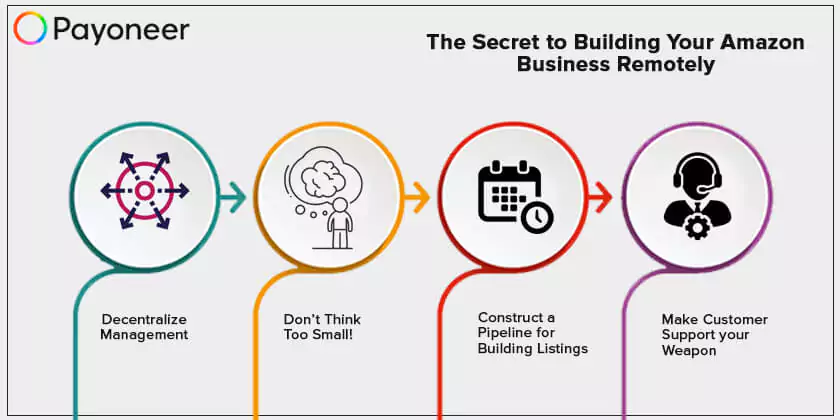The Secret to Building Your Amazon Business Remotely
The iconic imagery of Steve Jobs and Steve Wozniak building the very first Apple Computer I in their garage introduced the world to the household term: ‘The Garage Entrepreneur’. The founders of Google, Disney, HP, and Microsoft are all equally impressive members of the 20th-century ‘Back-yard Billionaire’ club, too. The New Age Entrepreneur “With an…

The iconic imagery of Steve Jobs and Steve Wozniak building the very first Apple Computer I in their garage introduced the world to the household term: ‘The Garage Entrepreneur’. The founders of Google, Disney, HP, and Microsoft are all equally impressive members of the 20th-century ‘Back-yard Billionaire’ club, too.
The New Age Entrepreneur
“With an increasing proportion of retail transitioning from in-store to online, eCommerce platforms have drastically reduced the barrier to entry for starting a business. At the forefront is Amazon – emerging as the industry giant by being the first platform to provide online sellers with a shipping and logistics solution.”
– Yoni Kozminski, Co-Founder, Multiply Mii, an end-to-end offshore staffing solution that helps small businesses outsource.
For those unfamiliar with the phenomenon – you can source your products in China, ship it via Hong Kong to an Amazon warehouse in Nevada, and sell it to a Canadian customer buying a product for his cousin in Puerto Rico – all without leaving your bedroom. Sounds easy, right?
Amazon Rewards Newcomers
Amazon sellers typically succeed at first. The Amazon algorithm even artificially generates ‘beginner’s luck’, to get sellers onboard. However, the “bedroom bloomer” bubble eventually bursts, and the owner might have to get dressed and venture downstairs, or perhaps even invest in an office.
Now with irresponsible amounts of inventory scattered around the world, a few negative reviews, and the holiday season fast approaching, the risk of not building a team to cover more ground far outweighs the danger of protecting your slim profit margins.
Eventually, Reality Hits
How should you expand your team? Where to invest in growth? Where to cut costs? A few anonymous negative reviews could slash your monthly revenue in half, or on the contrary, your inventory could suddenly sell out in a matter of days.
So, with so much to do, and so much to gain, yet so much to lose – what do you do?
The Solution: Offshoring
For this reason, many sellers have sought a happy medium by offshoring 4-5 roles for the price of one in-house employee. The beauty of selling on Amazon is that most of the tasks are methodical and decisions can be made unemotionally, making these roles perfect for outsourcing.
The Philippines is a great example. A country in which English is the official language and the low cost of living allows for reduced, yet respectable wages, the Filipino BPO industry is the secret weapon of the best players on Amazon. Unlike some traditional industries, in which companies are willing to mildly compromise the quality of work for reduced labor costs, Amazon sellers can expect to work with an employee in the Philippines with more experience on Amazon than any in-house candidate.
If the foundations of the outsourced relationship are properly established, as they are with a outsourced recruitment service like MultiplyMii, the quality of work should even increase by outsourcing to the Philippines, despite the 60-80% savings.
However, the challenge still remains of how, who, and when to grow your outsourced team?
While Amazon stores vary in their products and margins, the workload is still generally consistent, and most sellers follow a similar growth trajectory. Here is a model road map of how to scale your Amazon business by growing your remote team.
1. Decentralize Management
To begin, you should keep your team lean and simple to maintain close control over your business and slowly learn to feel comfortable trusting your outsourced team. Your first hire should always be a project manager (PM), to be your partner in building the offshore arm and filter the daily traffic. Instead of following up with multiple staff, you only need to speak to one PM on a regular basis. If your budget allows you to target the upper limit, you can find a seasoned professional with Amazon experience.
Continue to handle all financial and logistical matters, essentially relinquishing only your ‘marketing’ efforts to be handled by the PM. You should brainstorm concepts and strategy together, and then empower your PM to work with external contractors to execute on tasks.
The main projects to focus on are listing images, video, and copy. All these roles can be project-based to begin, however, eventually you will want to…
2. Construct a Pipeline for Building Listings
Graphic designers, content writers and video producers all take some time to adapt to your brand language and personal taste, as well as your management style. As soon as the workload justifies, you should seek to bring on these roles permanently and construct a conveyor belt for creating and updating Amazon listings.
You can control all aspects of your listing in the space of a 20-minute daily huddle with your project manager. With the right procedures in place, any changes or updates that you wish to make can be executed almost immediately, multiplying your output and freeing up your time for more important matters.
Try not to waste too much time searching for the perfect candidate, as you’re not a recruiter or HR specialist. The most effective method is to engage an outsourced recruitment service, that will understand your needs and provide you with qualified candidates to interview.
3. Make Customer Support your Weapon
Customer support can be handled by you or your PM for as long as it doesn’t take more than an hour a day. Once the traffic begins to accumulate, you should look to outsource your customer support function to be the strongest suit. Amazon’s CEO, Jeff Bezos, famously spends one week per year answering customer support tickets, strengthening the company’s commitment to customer excellence.
Inbound tickets are only one small element of Amazon customer support. Your customer support function needs to be expansive, to focus on customer reviews – both increasing positive reviews and removing negative. Seller feedback is an important area to focus on as well, ensuring that your seller ranking remains healthy and you deal with negative experiences before they escalate.
For most products, 90% of customer queries are repetitive and predictable, making customer support a simple function to outsource. Similarly, you can train support specialists to execute on any review strategy you may have and be confident that they can follow a structure process to arrive at results.
As with every other category, view this outsourcing endeavor as an effort to save time, not an effort to save money and have the peace of mind that your customers are getting the best service.
4. Don’t Think Too Small!
The common misconception of referring to the Filipino workforce as virtual assistants is the most inhibiting part of outsourcing. While the luxury of having someone to complete all your busy, unchallenged tasks are appealing, you will never be able to move your company forward with this attitude.
Seek team members that allow you to delegate responsibility, not tasks. If you can only delegate tasks, you will never be able to remove yourself from working ‘in’ the business.
This article has made it all seem easy – it’s not! You will encounter problems that make you wish you’d just stayed in your bedroom, selling a few products on Amazon to give you some spare change for the weekend.
But with a level-headed attitude and the right outsourcing partner, you can make Amazon your ticket to freedom, creating dozens of jobs along the way and creating a sellable asset.
Related resources
Latest articles
-
Planning to hire employees in Germany? Here’s a quick guide
Looking to hire employees in Japan for your U.S. company? Learn about hiring practices in Japan and how Payoneer Workforce Management makes it easy to hire in Japan.
-
Planning to hire employees in the Philippines? Here’s a quick guide
Wondering how an American company hires employees in the Philippines? Our guide covers how to hire employees in the Philippines and how we can help.
-
Planning to hire employees in Japan? Here’s a quick guide
Looking to hire employees in Japan for your U.S. company? Learn about hiring practices in Japan and how Payoneer Workforce Management makes it easy to hire in Japan.
-
Planning to hire in Hong Kong? Here’s a quick guide
Are you hiring employees in Hong Kong for your U.S. company? Learn about employment in Hong Kong and how Payoneer Workforce Management makes it easy to hire in Hong Kong.
-
Planning to hire in Colombia? Here’s a quick guide
Looking to hire employees in Colombia for your U.S. company? Learn about employment in Colombia and how Payoneer Workforce Management makes it easy to hire in Colombia.
-
Planning to hire employees in Brazil? Here’s a quick guide
Looking to hire employees in Brazil for your U.S. company? Learn about employment in Brazil and how Payoneer Workforce Management helps hire in Brazil.
Disclaimer
Nothing herein should be construed as if Payoneer Inc. or its affiliates are soliciting or inviting any person outside the jurisdiction where it operates/is licensed to engage in payment services provided by Payoneer Inc. or its affiliates, unless permitted by applicable laws. Any products/services availability are subject to customer’s eligibility. Not all products/services are available in all jurisdictions in the same manner. Depending on your eligibility, you may be offered with the Corporate Purchasing Mastercard, issued by First Century Bank, N.A., under a license by Mastercard® and provided to you by Payoneer Inc., or the Payoneer Business Premium Debit Mastercard®, issued and provided from Ireland by Payoneer Europe Limited under a license by Mastercard. The Payoneer Business Premium Debit Mastercard® cannot be used at merchants or ATMs in Hong Kong or for HKD payments. If you are located in the EEA, all Payoneer Services will be provided to you by Payoneer Europe Limited, trading as Payoneer and regulated by the Central Bank of Ireland.
The information in this document is intended to be of a general nature and does not constitute legal advice. While we have endeavored to ensure that the information is up to date and correct, we make no representations or warranties of any kind, express or implied, about the completeness, accuracy, reliability or suitability of the information. In no event will we be liable for any loss or damage including without limitation, indirect or consequential loss or damage, or any loss or damage whatsoever incurred in connection with the information provided.















